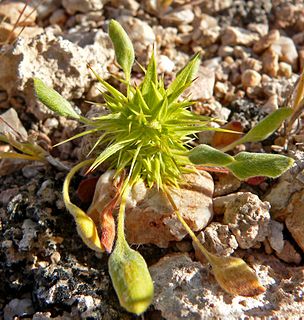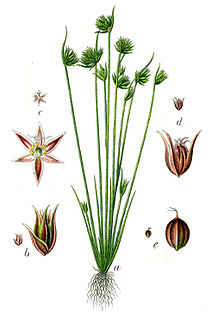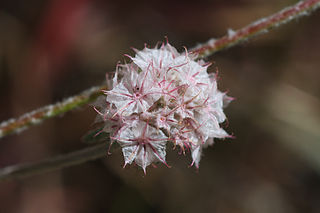
Cerastium glomeratum is a species of flowering plant in the family Caryophyllaceae known by the common names sticky mouse-ear chickweed and clammy chickweed. It is probably native to Eurasia but it is known on most continents as an introduced species. It grows in many types of habitat. The blooming period is February, March, April, and May.

Chorizanthe is a genus of plants in the buckwheat family known generally as spineflowers. These are small, squat, herbaceous plants with spiny-looking inflorescences of flowers. The flowers may be in shades of red or yellow to white. The bracts are pointed and sometimes tipped with a hooked awn, and the inflorescence often dries into a rounded, spiny husk. Spineflowers are found in western North America and South America.

Chorizanthe brevicornu is a species of flowering plant in the buckwheat family which is known by the common name brittle spineflower. It is native to the southwestern United States and northern Mexico, where it is widely distributed but is most abundant in the deserts.

Juncus capitatus is a species of rush known by the common names dwarf rush and leafybract dwarf rush. It is native to Europe, Asia and North Africa. It is also an introduced species in parts of North America such as California and the Gulf Coast. It grows in moist areas, such as wet sand, vernal pools, and ditches.

Claytonia exigua is a species of wildflower known by the common names serpentine springbeauty and pale claytonia, in the family Montiaceae.

Chorizanthe parryi is a species of flowering plant in the buckwheat family known by the common name Parry's spineflower and San Bernardino spineflower.

Chorizanthe cuspidata is a species of flowering plant in the buckwheat family known by the common name San Francisco spineflower. It is endemic to California, where it is known only from the San Francisco Bay Area and to the immediate north and south. It grows in sandy coastal habitat.
Chorizanthe diffusa is a species of flowering plant in the buckwheat family known by the common name diffuse spineflower. It is endemic to California, where it grows on the coastline and mountains of the Central Coast, in sandy scrub, woodland, and forest habitat. It is erect to prostrate in form, its stem generally no longer than 15 or 20 centimeters. The leaves are up to 2 centimeters long and mainly arranged about the base of the plant. The inflorescence is a cluster of flowers, each surrounded by six hook-tipped bracts. The margins of the bracts proximal to the long hooked tip may be very thin and nearly invisible to wide and obvious, and they may be green to white to purplish. The flower itself is about 3 millimeters wide and white with a yellow throat. The tips of its tepals may be smooth or jagged or toothed.

Chorizanthe douglasii is a species of flowering plant in the buckwheat family known by the common names San Benito spineflower and Douglas' spineflower. It is endemic to California, where it grows in the mountains of the Southern California Coast Ranges, from the Santa Lucia Range east to the Gabilan Range.
Chorizanthe howellii is a species of flowering plant in the buckwheat family known by the common names Mendocino spineflower and Howell's spineflower. It is endemic to coastal Mendocino County, California, where it is known only from the sand dunes and coastal scrub near Fort Bragg. It is estimated that 95% of the remaining individuals of this plant are part of a single population growing at MacKerricher State Park. It is a federally listed endangered species.
Chorizanthe leptotheca is a species of flowering plant in the buckwheat family known by the common names Ramona spineflower and Peninsular spineflower. It is native to the Peninsular Ranges of southern California and Baja California, where it grows in chaparral and forest habitat. It is very similar to its close relative, Turkish rugging.

Chorizanthe membranacea is a species of flowering plant in the buckwheat family known by the common name pink spineflower. It is native to Oregon and California, where it is widespread and in some areas quite common. It can be found in a wide variety of habitats.
Chorizanthe obovata is a species of flowering plant in the buckwheat family known by the common name spoonsepal spineflower. It is endemic to California, where it grows in the mountains of the Central Coast Range from Monterey to Santa Barbara Counties.
Chorizanthe palmeri is a species of flowering plant in the buckwheat family known by the common name Palmer's spineflower. It is endemic to California, where it is known only from the Central Coast Ranges of western Monterey and San Luis Obispo Counties.
Chorizanthe polygonoides is a species of flowering plant in the buckwheat family known by the common name knotweed spineflower. It is native to California and Baja California, where it grows widely scattered in many types of habitat. It is a petite plant taking a prostrate form with stems just a few centimeters long at maximum. It may be green to red in color and is hairy in texture. The leaves are no more than a centimeter long and the flower is under two millimeters wide. The minute flower is surrounded by three hairy point-tipped bracts.

Chorizanthe pungens is a species of flowering plant in the buckwheat family known by the common name Monterey spineflower. It is endemic to California, where it is known from the San Francisco Bay Area south along the Central Coast.
Chorizanthe rectispina is a species of flowering plant in the buckwheat family known by the common names prickly spineflower and straight-awned spineflower. It is endemic to California, where it is known from about twenty occurrences from Monterey to Santa Barbara Counties. It grows in dry habitat types such as chaparral and woodland in the hills of the Central Coast Ranges. It is a low, spreading plant with stems up to about 25 centimeters long, grayish to greenish in color and hairy in texture. The inflorescence is a cluster of flowers, each flower surrounded by six hairy bracts which are grayish to pink in color and tipped with awns. One bract is longer than the others and has a straight awn, and the other smaller bracts may have hooked awns. The tiny flower at the center of the bract array is a few millimeters wide and white and yellow in color.
Chorizanthe uniaristata is a species of flowering plant in the buckwheat family known by the common name one-awn spineflower. It is endemic to central California, where it is known from several of the local mountain ranges, as well as the Central Coast.
Chorizanthe wheeleri is a rare species of flowering plant in the buckwheat family known by the common names Santa Barbara spineflower and Wheeler's spineflower. It is endemic to Santa Cruz and Santa Rosa Islands, two of the Channel Islands of California.
Minuartia pusilla is a species of flowering plant in the family Caryophyllaceae known by the common names annual sandwort and dwarf stitchwort.










